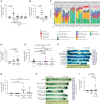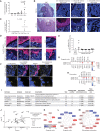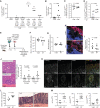Human Colon Cancer-Derived Clostridioides difficile Strains Drive Colonic Tumorigenesis in Mice
- PMID: 35678528
- PMCID: PMC9357196
- DOI: 10.1158/2159-8290.CD-21-1273
Human Colon Cancer-Derived Clostridioides difficile Strains Drive Colonic Tumorigenesis in Mice
Abstract
Defining the complex role of the microbiome in colorectal cancer and the discovery of novel, protumorigenic microbes are areas of active investigation. In the present study, culturing and reassociation experiments revealed that toxigenic strains of Clostridioides difficile drove the tumorigenic phenotype of a subset of colorectal cancer patient-derived mucosal slurries in germ-free ApcMin/+ mice. Tumorigenesis was dependent on the C. difficile toxin TcdB and was associated with induction of Wnt signaling, reactive oxygen species, and protumorigenic mucosal immune responses marked by the infiltration of activated myeloid cells and IL17-producing lymphoid and innate lymphoid cell subsets. These findings suggest that chronic colonization with toxigenic C. difficile is a potential driver of colorectal cancer in patients.
Significance: Colorectal cancer is a leading cause of cancer and cancer-related deaths worldwide, with a multifactorial etiology that likely includes procarcinogenic bacteria. Using human colon cancer specimens, culturing, and murine models, we demonstrate that chronic infection with the enteric pathogen C. difficile is a previously unrecognized contributor to colonic tumorigenesis. See related commentary by Jain and Dudeja, p. 1838. This article is highlighted in the In This Issue feature, p. 1825.
©2022 The Authors; Published by the American Association for Cancer Research.
Figures




Comment in
-
Hiding in Plain Sight: A Novel Microbial Driver for Colorectal Cancer?Cancer Discov. 2022 Aug 5;12(8):1838-1840. doi: 10.1158/2159-8290.CD-22-0612. Cancer Discov. 2022. PMID: 35929130
References
-
- Wong SH, Zhao L, Zhang X, Nakatsu G, Han J, Xu W, et al. . Gavage of fecal samples from patients with colorectal cancer promotes intestinal carcinogenesis in germ-free and conventional mice. Gastroenterology 2017;153:1621–33. - PubMed
Publication types
MeSH terms
Substances
Grants and funding
- R01 DK073338/DK/NIDDK NIH HHS/United States
- IK2 BX005699/BX/BLRD VA/United States
- T32 GM136577/GM/NIGMS NIH HHS/United States
- R35 CA197570/CA/NCI NIH HHS/United States
- P30 DK058404/DK/NIDDK NIH HHS/United States
- R01 CA203891/CA/NCI NIH HHS/United States
- R01 CA196845/CA/NCI NIH HHS/United States
- U2C CA233291/CA/NCI NIH HHS/United States
- 27140/CRUK_/Cancer Research UK/United Kingdom
- S10 OD016374/OD/NIH HHS/United States
- P50 CA236733/CA/NCI NIH HHS/United States
- R00 CA230192/CA/NCI NIH HHS/United States
- R01 DK103831/DK/NIDDK NIH HHS/United States
- P30 DK089502/DK/NIDDK NIH HHS/United States
- T32 CA009110/CA/NCI NIH HHS/United States
LinkOut - more resources
Full Text Sources
Medical
Molecular Biology Databases

